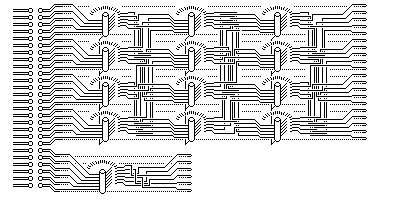PURPLE, CORAL, and JADE (original) (raw)
[Next] [Up] [Previous] [Index]
The Japanese cipher machine which the American cryptanalysts codenamed CORAL is perhaps the easiest to understand of the three.
All three machines were built from common telephone stepping switches. These switches had six input wires. Each wire was connected to a wiper, and each wiper could make contact with one of twenty-five terminals. All six wipers moved together, and each one had its own set of 25 terminals to contact.
A solenoid controlled the movement of the wipers. When a current pulse was fed to it, the wipers advanced one position, except that, if the wipers were already at position 25, a spring caused the wipers to go back to the first position. Thus, although the 25 terminals were arranged in a semicircle, the switch acted as though they formed a full circle, with stepping in only one direction.
In CORAL, a stack of five stepping switches did the same job as a rotor would do in a Hebern rotor machine. 26 input wires carried current to 26 outputs, in 25 different ways. The alphabets for each of the 25 wiper positions, unlike the alphabets for the different positions of a rotor, were completely independent and unrelated.
JADE was just about the same as CORAL, except that it was used to encipher messages written with the Japanese katakana syllabary, which has 48 symbols. Thus, it added a shift key to the keyboard. This shift key accompanied a 25-symbol alphabet, which gave equivalents to the 48 kana and the two diacritical marks used with katakana.
This characteristic was a weakness, since if one had some probable plaintext to try, the positions of shifted and unshifted characters would make it easy to find places to try that probable plaintext. JADE had another weakness; the plugboard, instead of being present on both input and output, only scrambled the ciphertext in this machine, which would have made it easier to relate patterns in plaintext to the wiring of the stepping switches. Since the other machines in that series did not work this way, it has been speculated that the cause was an error by the draftsman who prepared the plans to use in manufacturing the machine.
PURPLE, the earliest of the three machines, had a somewhat stranger structure. A plugboard selected 20 letters of the alphabet to be enciphered through banks of four stepping switches. The other six letters were enciphered by means of only one stepping switch. This division of the alphabet was easily detected through frequency counts, and was perhaps the most serious weakness of the machine. (Another very serious weakness, and also a strong contender for the title of "most serious", was the fact that the stepping switch banks were, for obvious reasons, not removable, so one could never perform the operation equivalent to changing the rotor order.)
The following diagram:

attempts, with many parts omitted, to illustrate how PURPLE worked. The plugboard reassigned letters for both input and output. The stepping switches only have fifteen tick marks around them - representing the 25 contacts each wiper actually has. For only one wiper position for each switch or bank of ganged switches, the scrambled arrangement in which the wires are connected to corresponding wires in the next stage are shown. However, the 20 versus 6 division is easily visible in the diagram, as is the general arrangement of the device.
The three banks of stepping switches advanced in the traditional odometer like fashion except for two minor modifications; when the fast one advanced 25 steps, the medium one would advance one step after the next letter was enciphered, so that the machine's alphabets were in groups of 26, and when the medium one advanced 25 steps, the slow one would advance one step, but it would do so before the encipherment of the letter that preceded that advancement. Thus, if I understood this correctly, the switch positions advanced like this:
S M F 1 24 22 1 24 23 1 24 24 1 24 25 1 25 25 1 25 1 1 25 2 ... 1 25 24 2 25 25 2 1 25 2 1 1 2 1 2
A switch allowed all six possibilities of which bank was fast, medium, or slow to be selected.
The wiring of the plugboard was part of the daily secret key of the machine, as was the pattern of stepping switch bank movement. The starting positions of the stepping switches for each message were communicated by an indicator. Both the plugboard wirings and the stepping switch start points came from a book which contained all the possibilities that were used, which were limited in number compared to all the possibilities that could be used with the machine.
The switch on CORAL that varied which banks of stepping switches were slow, medium, and fast allowed only three of the six possibilities for that.